From Third World to First- Lee Kuan Yew
From Third World to First by Lee Kuan Yew, the Founding Father and former Prime Minister of Singapore is a story of how Singapore was built and became an economic powerhouse. Not only do you learn about Singapore, but you also learn about the history and politics of several other countries like Indonesia, the Philippines, Myanmar, Cambodia, and more.
I have read books on Entrepreneurship, starting a company, business, autobiography/biography of business leaders. However, never read one on starting(building) a country from scratch. I got to learn about the existence of this book when I was listening to this podcast by Tim Ferris with Balaji Srinivasan. It was exciting that From Third World to First was written by the man himself, Lee Kuan Yew – the founding father of Singapore. This book is close to 700 pages. I have documented my learning chapter by chapter so it could also be a reference.
Part 1
Getting the Basics Right
1.Doing it Alone
Lee Kuan Yew describes that there are books to teach you how to build a house, how to repair engines, and how to write a book. However, he has not seen one that teaches you how to build a nation. He never expected that in 1965 at the age of 42, he would be incharge of an independent Singapore and for the lives of its 2 million people. From 1959, at the age of 35, Lee Kuan Yew was the Prime Minister of a self-governing state of Singapore. They joined the federation of Malaysia in September 1963 and all of a sudden on 9 August 1965, they were on their own as an independent nation. They were asked to leave Malaysia.
2. Building an Army from Scratch
Singapore started from scratch, as they needed to protect themselves from the invasion from Malaysia or other neighbors. Lee Kuan Yew wrote a letter to the then Prime Minister of India on setting up their armed forces. When it comes to defense, more than the size of the country, it is the size of the armed forces that matter.
Lee Kuan Yew also talks about invoking patriotism amongst everyone, working on a cultural mindset change, setting up NCC – National Cadet Corps -so the discipline and serving are inculcated right from the school. The best officers of the SAF (Singapore Armed Forces) are provided an opportunity to learn abroad at some of the best universities in the world (fully paid tuition and more) with an eight-year commitment to come back and serve the country.
3. Britain Pulls Out
One can learn about how foreign relations work. Britain wanted to invest more in its own economic interests and pull out of Singapore. Lee Kuan Yew’s visits to the United Kingdom and other countries are detailed. Lee Kuan Yew also talks about his little gossip with other world leaders. Britain pulled out its military forces between 1968 and 1971.
4. Surviving Without a Hinterland
Singapore set up the Economic Development Board (EDB)- One of the first things the Government did was to promote tourism – the Singapore Tourist Promotion Board / Singapore Tourism was set up. Runme Shaw was the chairman of the board, and Merlion (Lion with mermaid’s tail) was designed as the official symbol of Singapore. The Economic Development Board (EDB) was set up in August of 1961 to lure multinational companies to Singapore. The strategic bet on America helped transform Singapore. Companies like Texas Instruments, Hewlett Packard, GE set up plants in Singapore. Soon by the 1980’s Singapore became a major exporter of electronics.
When businessmen visited Singapore, they ensured they had clean roads from the airport to their hotels with a lot of greenery. Public enterprises like Singapore Airlines were set up with the goal to run with profits or they were shut down. Lee Kuan Yew made multiple visits to the United States and the West visiting business leaders. They spread the bets (as Research and Development is always an experiment, they invested in multiple areas). Albert Winsemius, a Dutch economist, served as the economic advisor to Singapore from 1961 to 1984.
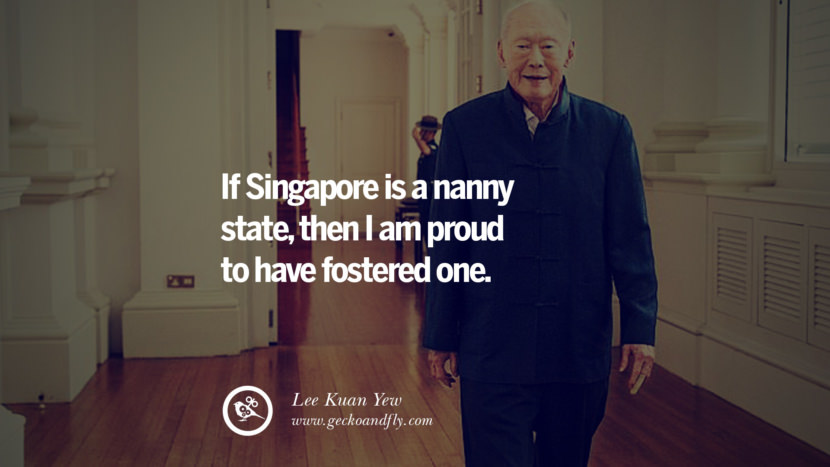
5. Creating a Financial Center
Lee Kuan Yew also talks about setting up a financial center and how they weathered the different international financial storms. They also refined the systems along the way with respect to the stock market rules and more. Post-1990 they also opened up more giving more leeway to the financial institutions to try new products and more.
6. Winning Over the Unions
Lee Kuan Yew nullified or made the trade unions less relevant. For example, the trade unions had triple pay on public holidays to cleansing workers. Work would be piled and the workers would complete the work on a holiday. He had to make Singapore more competitive and they set up systems to educate the workers and also the employers.
7. A Fair, Not a Welfare Society
A sense of belonging was created by creating public housing and ensuring that people owned the houses (similar to Tamil Nadu Housing Board, in Tamil Nadu, India). However, the houses/apartments were upgraded at regular intervals. Houses were also better maintained as the laborers owned them. They went on to construct more houses than what they could handle and it hit the quality. Lee Kyan Yew says ‘It does not pay to yield to popular pressure beyond our capacity to deliver’.
Provident Funds were set up so people could save for retirement and reforms in healthcare were done. He did not want Singapore to be a welfare state where everything was provided for free. The SBS – Singapore Bus Services was set up and listed on the stock exchange. People were encouraged to purchase shares and discounts were provided.
Lee Kuan Yew wanted the people of Singapore to hold shares in major public companies to create a sense of belonging and feel a part of the growth. Profit went back to the workers and there was less incentive to demand cheaper fares. (This is something India could copy – though we have done a bit of all this, we should sustain our enterprises better).
8. The Communists Self-Destruct
The Communists tried to gain control of Singapore on multiple occasions and they were put off. Some of the Communist leaders were allowed to return to Singapore after quitting politics and declaring all their past communist links. Lee Kuan Yew talks about several old communist leaders including Lim Chin Siong who was freed from jail, went to Britain, and later allowed to re-enter Singapore. One thing was clear- Lee Kyan Yew was the clear boss and other leaders had to fall in line. However, he ensured that he never abused power.
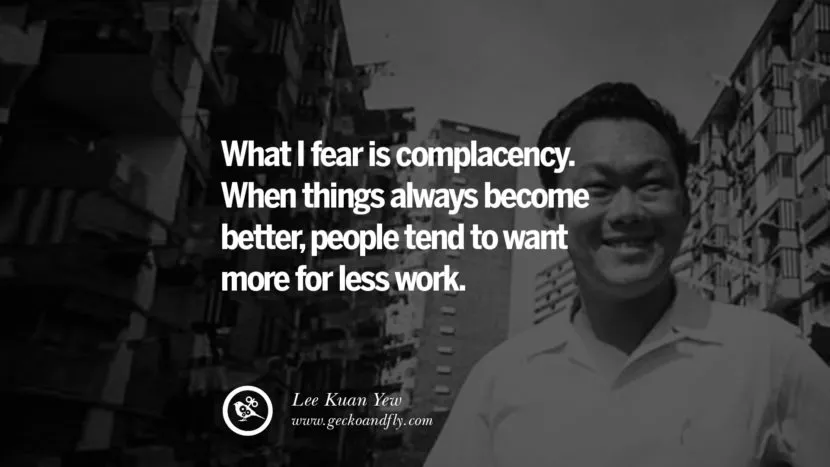
9. Straddling the Middle Ground
Lee Kuan Yew talks about how he and his party consolidated power and how the opposition could not take off in Singapore. Consistent good work did help the PAP (People’s Action Party). The opposition was crushed in elections and the PAP had very successful stints for decades.
10. Nurturing and Attracting Talent
Lee Kuan Yew admits to dropping a bombshell when in one of the speeches he said that educated Singapore men should marry only educated women and not uneducated women so the children become better educated. He claims to have done a lot of research on this. He also ran campaigns to this effect. However, even educated women did not like this approach. One might have a lot of differences with Lee Kuan Yew’s style of functioning here and may not agree with everything.
11. Many Tongues, One Language
English, Malay, Chinese, and Tamil were considered the official languages of Singapore. English was used as the primary language to communicate. Lee Kuan Yew was never up for Chinese as the first language. However, his three children were educated in Chinese schools (unlike some of the leaders who advocated Chinese but put their children in English schools). It helped their children learn the Chinese culture and values. They also specifically ran Speak Mandarin (instead of a Chinese dialect campaign), and Lee Kuan Yew predicts in a couple of generations that Mandarin will become the mother tongue of all Singaporeans and not dialects like Hokkien.
12. Keeping the Government Clean
Lee Kuan Yew ensured the Government was honest and he also increased the pay of the Ministers to stay competitive to that of the private sector. When they took oath at a ceremony in the city council chamber in June 1959, they all wore white shirts and white slacks to symbolize purity and honesty in their personal behavior in public life. No one was spared and the guilty were punished. When the opposition had raised questions about an apartment he had bought at discounted prices, an inquiry was ordered and Lee Kuan Yew came out clean. Traffic police getting bribes is a common scene in Asian countries and with effective leadership at the top, all these practices had to go in Singapore.
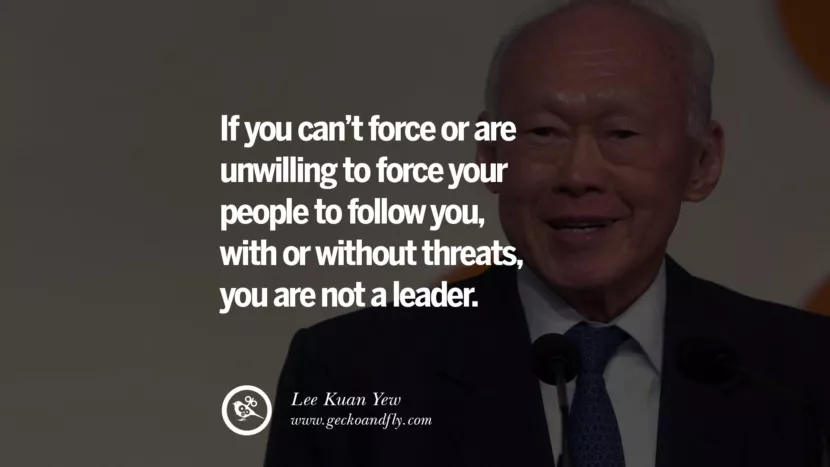
13. Greening Singapore
People spitting on the streets was a common practice. The Government ran campaigns to eradicate the same. However before they could do all this, they created more employment opportunities and improved the quality of life. Lee Kuan Yew also banned firecrackers (usually burst during the Chinese New Year). He was of the firm belief that some old practices had to go. All manufacturers were also asked to plant trees in their factories before they could begin work.
Lee Kuan Yew was visiting Boston in 1970. He saw a line of cars that were waiting in line to be certified for the emissions. He came back to Singapore and set up the Anti Pollution Unit. Cleaning up the Singapore river was also a big part of his initiative and he had to work extra hard to get this done. They imported sand from Indonesia for the shores. Behind every successful project was a competent officer.
14. Managing (Controlling) the Media
Lee Kuan Yew talks about foreign interference in the domestic media. Lee Kuan Yew did not believe that the media could write anything and the interests of Singapore always had to be protected. Newspapers cannot instigate violence and newspapers also played an important role in governance. When the news media did not toe the Government’s line the circulation of newspaper copies was capped. The ban (cap) was lifted once they toed the Government’s line. It was the responsibility of the newspapers or media houses to check the facts and publish content.
15. Conductor of an Orchestra
In this chapter, Lee Kuan Yew talks about the appointments of the Chief Justice and Presidents. Lee appointed Yong Pung How as the Chief Justice of Singapore and it helped turn around the judicial system. Cases were completed a lot faster and technology was used. Appointment of the right people in the job is the key. Lee cites his version of the story on the appointment of Devan Nair as the President of Singapore in 1981 and how he was not so lucky with the appointment. He also talks about the resettlement of some communities and the challenges they ran into. To overcome the poor performance of Malay students in Mathematics, they set up a cultural organization to help with this, and soon, the Indian and Chinese diaspora followed. One thing I found interesting was that Lee Kuan Yew took an interest even in little things.
Part II
In Search of Space- Regional and International
16. Ups and Downs with Malaysia
On March 20, 1966, Singapore was separated from Malaysia. He talks about his personal experiences with Tunku Abdul Rahman, the then Prime Minister of Malaysia. Separate currencies were issued (Singapore Dollars & Malaysian Ringgit) in June 1967. In due course, the Malaysian ringgit started dropping as compared to the Singapore dollar. Not spending more than what they collect has been the guiding principle of Singapore which no finance minister has departed except in a recession. Lee Kuan Yew’s relationship with different Prime Ministers of Malaysia is also shared (especially with Dr. Mahathir Mohamad).
The fundamental difference between Singapore and Malaysia is that Singapore is a multicultural society and opportunities are based on merit as opposed to Malaysia where Malay’s are given a preference. Malaysia also built world-class airports which caused Singapore to re-look at its infrastructure and modernize it. The differences between the two countries will always exist, however, the two countries have learned to co-exist.
17. Indonesia – From Foe to Friend
This chapter was a very interesting read to understand the politics of Indonesia between the 1960s and 1990s. Lee Kuan Yew’s friendship and ties with the Founding Fathers – Sukarno and later President Suharto are discussed. The era of President Suharto was a great read. According to Lee, President Suharto did a lot to improve the living standards in Indonesia. However towards the end of his political career, he had brought in his family members and they were part of industries, banks, and more.
During Suharto’s rule, Indonesia went onto the Rupiah crisis where the rupiah started depreciating in value relative to the US dollar. In January 1998, Indonesia’s rupiah dropped from 7,500 to 10,000 (before the crises the Rupiah was 2,500 to the U.S dollar). Rupiah then skidded to 17,000 to the US dollar. The Indonesian government did not heed the advice of the IMF (International Monetary Fund).
Eventually, Suharto had to resign and B.J Habibie became President. Lee Kuan Yew thinks that Suharto deserved a much better exit if not for the crisis President Suharto had created (partly because of nepotism). It was then followed by President Gus Dur (with whom Singapore shared a good relationship) and Megawati Sukarnoputri (President Sukarno’s daughter) was appointed Vice President. However, things have changed quite a bit where Power is no longer in the hands of the President backed by an all-powerful ABRI, the armed forces.

18. Building Ties with Thailand, the Philippines, and Brunei
Reading this chapter, you get to understand the politics of the ASEAN region in the ’70s and ’80s. One more thing you realize is that cash for votes (which is common in India today) is not something new and it has been existent in Asian countries. You do need to have funds and wealth to run a political party and eventually to rule the country. Lee Kuan Yew met Thailand’s Prime Minister Field Marshal Thanom Kittikachorn in Bangkok in 1966. They shared a good rapport and were friends. Thanom had to depart to the United States (on exile) and later Lee agreed for Thanom and his family to take up residence in Singapore.
The Thai Government returned a good part of Thanom’s assets to him. Forgiving is an essential part of Buddhism. General Chatchai Choonhaven became Prime Minister in August 1998. Lee asked Chatchai what he learned from Newspapers – that often headman was paid to ensure he delivered the votes of his villagers.
In 1974 Lee Kuan Yew visited the Philippines and Ferdinand Marcos was the President. Marcos was a dictator and also amassed a lot of wealth. His opposition leader Benigno Aquino was sent in exile to the United States. When Benigno Aquino returned to the Philippines, he was shot dead. This eventually led to political instability and Marcos had to be exiled to Hawaii in the United States in February 1986 (Marcos shared a good rapport with US President Reagan and it helped).
Benigno Aquino’s wife Corazon Aquino became the President. But for the political instability and lack of leadership, Lee Kuan Yew saw no reason why the Philippines should not have been one of the most successful ASEAN countries. Lee Kuan Yew’s quote on the Philippines ‘It is a soft, forgiving culture. Only in the Philippines could a leader like Ferdinand Marcos, who pillaged his country for over 20 years, still be considered for a national burial. Insignificant amounts of the loot have been recovered, yet his wife and children were allowed to return and engage in politics.’
Brunei was under British rule and became independent in 1984. Sir Omar Ali Saifuddien decided not to join Malaysia and it proved to be a prudent decision.
19. Vietnam, Myanmar, and Cambodia – Coming to Terms With the Modern World
Pham Van Dong was the Prime Minister of Vietnam when Lee Kuan Yew visited Vietnam. He did not have cordial relations and Pham said that Singapore had benefited from the Vietnam war selling military equipment to the US. They wanted aid from Singapore and Lee Kuan Yew was not ready to budge. Vo Van Kiet the next Prime Minister wanted Lee Kuan Yew to be the economic advisor to Vietnam. He agreed to visit them and Lee suggested that Ho Chi Minh City (formerly Saigon) be the dynamo to get growth across Vietnam. Vietnam has been a victim of war and it does not help any party, – War only hurts the people (We could also relate this to what happened in Sri Lanka).
Lee Kuan Yew’s first visit to Rangoon (Yangon) was in April 1962. Prime Minister U Nu of Burma had asked General Ne Win of Burma (as Myanmar was called before 1989) to take over. Later Burma became under constant military rule. Ne Win and Lee Kuan Yew shared a good friendship and Nee Win advised Lee Kuan Yew on mediation.
Lee Kuan Yew suggested that Aung San Suu Kyi, daughter of Burma’s hero and first prime minister Aung San, be freed. Lee Kyan Yew feels that the generals will sooner or later adjust their way of governance with more exposure and relationship with the external world. In his later visits, Lee was disappointed to see Burma get worse in terms of infrastructure and more.
Cambodia was the oasis of peace and prosperity. Choo and Lee Kuan Yew visited Cambodia first in 1962 to Phnom Penh, its capital. Prince Norodom Sihanouk personally greeted them. In a coup, Sihanouk had to flee Cambodia to Beijing. Cambodia became worse in his absence. Lee had met Sihanouk’s son Prince Ranariddh several times between 1981 and 1991. After the 1991 settlement (Vietnam got out of Cambodia), Ranariddh became the first Prime Minister. However, he could not hold on to power for long giving it away to Hun Sen (who became the second Prime Minister). To put Cambodia together will be a slow and laborious task. Lee Kuan Yew feels history has been cruel to the Cambodian people.
20. ASEAN – Unpromising Start, Promising Future
ASEAN was formed in August 1967 with Indonesia, Malaysia, Singapore as members. The key agenda was to protect North Vietnam, China, and the Soviet Union. The ASEAN membership helped as Australia was trying to change aviation policy to route direct flights between Australia and Britain bypassing the stopovers in ASEAN countries and creating restrictions. With solidarity, they were able to work with Australia to resolve this better together. ASEAN members also worked on liberating Cambodia from Vietnam. They installed Prince Ranariddh as the first Prime Minister and Hun Sun as the second Prime Minister. Vietnam became an ASEAN member in 1995, Myanmar and Laos in 1997, and Cambodia in 1999.
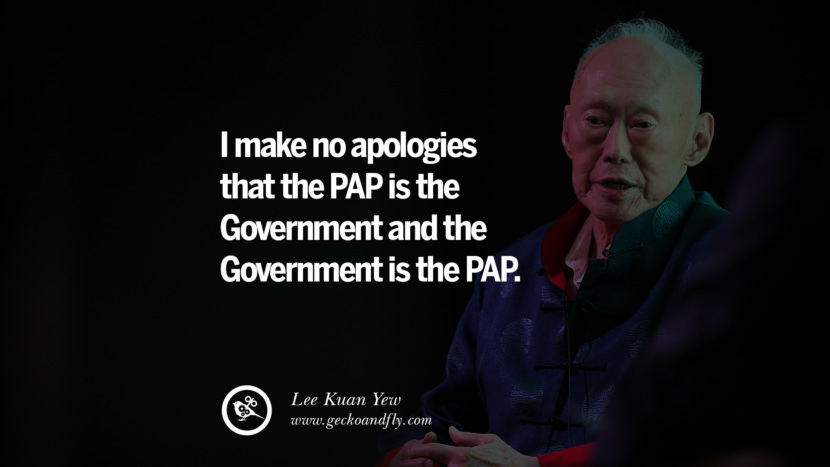
21. East Asia Crisis (1997-1999)
Public officers are referees and should not be market participants. Not following this principle caused a lot of currency and economic crises in East Asia.
22. Inside the Commonwealth Club
Singapore hosted the Commonwealth conference in January 1971. The sale of arms to African countries by Britain was discussed. Since Singapore was the host, Lee Kuan Yew had to sit through all prepared speeches regardless of what was already being discussed. It became boring at times. He also discusses his encounters with Pierre Trudeau, Prime Minister of Canada (who was bi-cultural), very fluent in French and English. Sheik Mujibur Rahman who led East Pakistan to independence as Bangladesh arrived in style for one of the commonwealth conferences (with a private jet) while Lee Kuan Yew was very frugal in his travel habits.
Uganda had a lot of Indians and they could have used the talent well and been prosperous. Lee Kuan Yew also discusses his encounters with Benazir Bhutto of Pakistan, her husband Asif Ali Sardari, and President Jayawardene of Sri Lanka. One of the commonwealth conferences was held in Nassau, Bahamas (October 1985), the playground of wealthy Americans. Lee Kuan Yew was delighted to receive a couple of British honors, however, he did not find it appropriate to use the title, Sir.
23. New Bonds with Britain
In this chapter, Lee Kuan Yew discusses his association with the different Prime Ministers of Britain. Because he served as the Prime Ministers of Singapore for an extended period of time, he had the opportunity to interact with the different Prime Ministers in the office. He outlines that Singapore is not a welfare State, unlike Britain. Prime Minister Margaret Thatcher worked on bringing back Britain on track and she believed in the free market economy. The per capita income of Singaporeans kept raising as compared to the British. There were also British schools set up in Singapore to cater to the 10,000 British families in Singapore. Lee Kuan Yew also discusses his association with Prime Minister Tony Blair of the United Kingdom.
24. Ties With Australia and New Zealand
The Australian media was not reporting on the progress East Asia was making with respect to Research & Development, their smart engineers, and more. Eventually, Australia opened up more to East Asia. Lee Kuan Yew recalls his interaction with the Australian Prime Minister, John Howard. Australia sent troops to East Timor. President Habibie of Indonesia called for a referendum on East Timor in the 1990s (which was a mistake) and 80% voted yes to be independent of Indonesia.
Gough Whitlam, one of the Australian Prime Ministers, was difficult to deal with and he wanted Singapore to take on 8000 Vietnam refugees which Lee Kuan Yew did not agree with. Australia is a country rich in minerals (Diamonds, Gold, Coal, and Uranium).
New Zealand depended a lot on Agriculture. Prime Minister Norman Kirk died after a few months of his meeting with Lee Kuan Yew in 1974. New Zealand wanted to be a part of the Asia Europe Meeting (ASEM), However, Malaysian Prime Minister Mahathir opposed the same. Lee thinks that countries will not be divided by regions in the future and technology has made the world smaller. New Zealanders always honored their agreements.
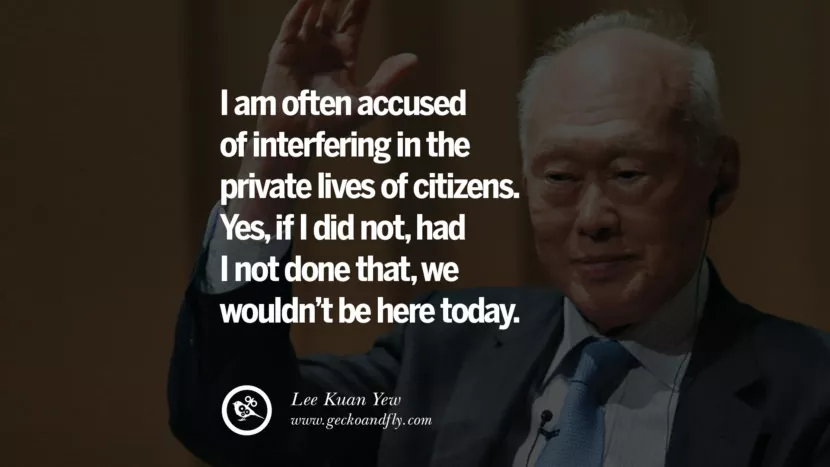
25. South Asia’s Legends and Leaders
Halfway through the book, I was wondering why there was not a lot of mention about India or its leaders. This chapter is all about India, Srilanka, and Pakistan. Lee Kuan Yew had read Pandit Jawaharlal Nehru’s books and his letters to his daughter Indira. Though Nehru might have had shortcomings he was a man of ideas. Lee Kuan Yew met Nehru a few times and also shortly before Nehru’s death in 1964. Though India had a lot of promises, Lee Kuan Yew says it was sad to see India’s gradual run down.
He says political leaders were wearing homespun clothes while they quietly amassed wealth. He also notes his interactions and observations of Indira Gandhi. Indira was practical and pragmatic, however, she was primarily concerned about the mechanics of power and this also led to her Sikh bodyguards assassinating her. When Rajiv Gandhi came to power, Lee Kuan Yew tried to establish ties with him and he also interacted with Natwar Singh the deputy foreign minister (sharp mind and a good presenter of India’s difficult political positions). Lee Kuan Yew says Rajiv was politically innocent. Rajiv often used to turn to Natwar Singh for help when discussing with Lee Kuan Yew. Lee felt that Rajiv had good intentions while sending the army to Sri Lanka. However, Rajiv ended up getting killed near Madras.
Lee Kuan Yew also understood how India worked (where Universities allocate a quote of their seats to their MP’s (Member of Parliament) who either sold it or gave it to their constituents. There was corruption and India needs to be decentralized. Delhi became more polluted in the 1990s as compared to the 1960s when he visited.
When Lee Kuan Yew talks about Srilanka, he says that he watched a promising country go to waste. Prime Minister Sirimavo Ratwatte Dias Bandaranaike changed the country’s name from Ceylon to Sri Lanka in 1972. However, it did not change the fortunes of the country. Prime Minister Jeyewardene said he would offer autonomy to the Tamils in Jaffna. But he did not and this led to civil war in 1983 and destroyed any hope for prosperous Sri Lanka for many years if not generations. Sri Lanka wanted to start an airline and Lee Kuan Yew advised against it. He felt that the money was better invested in irrigation, agriculture, housing, and more.
Lee Kuan Yew also describes his visits to Pakistan and his dealing with the different Prime Ministers including Nawaz Sharif, Benazir Bhutto, and more. He mentions that Pakistan could not execute their ideas through the Prime Ministers told him that they want to make a difference.
Reading his observations of India, Sri Lanka and Pakistan one gets a feeling that Lee Kuan Yew was very well-read, listened to a lot of people, and a keen observer of the world. It was good to read an International Leader’s perspective on India and he nailed it with respect to his observations.
26. Following Britain into Europe
Lee Kuan Yew felt Britain was a protectionist. He shares his experiences with France and Germany. French had and have aspirations to have their language as the leading language for International diplomacy. However, they could not get universal adaptability. He likened Singapore to West Berlin. Kohl as the Chancellor
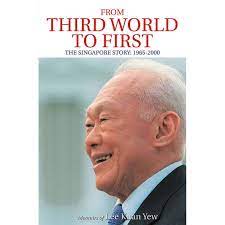


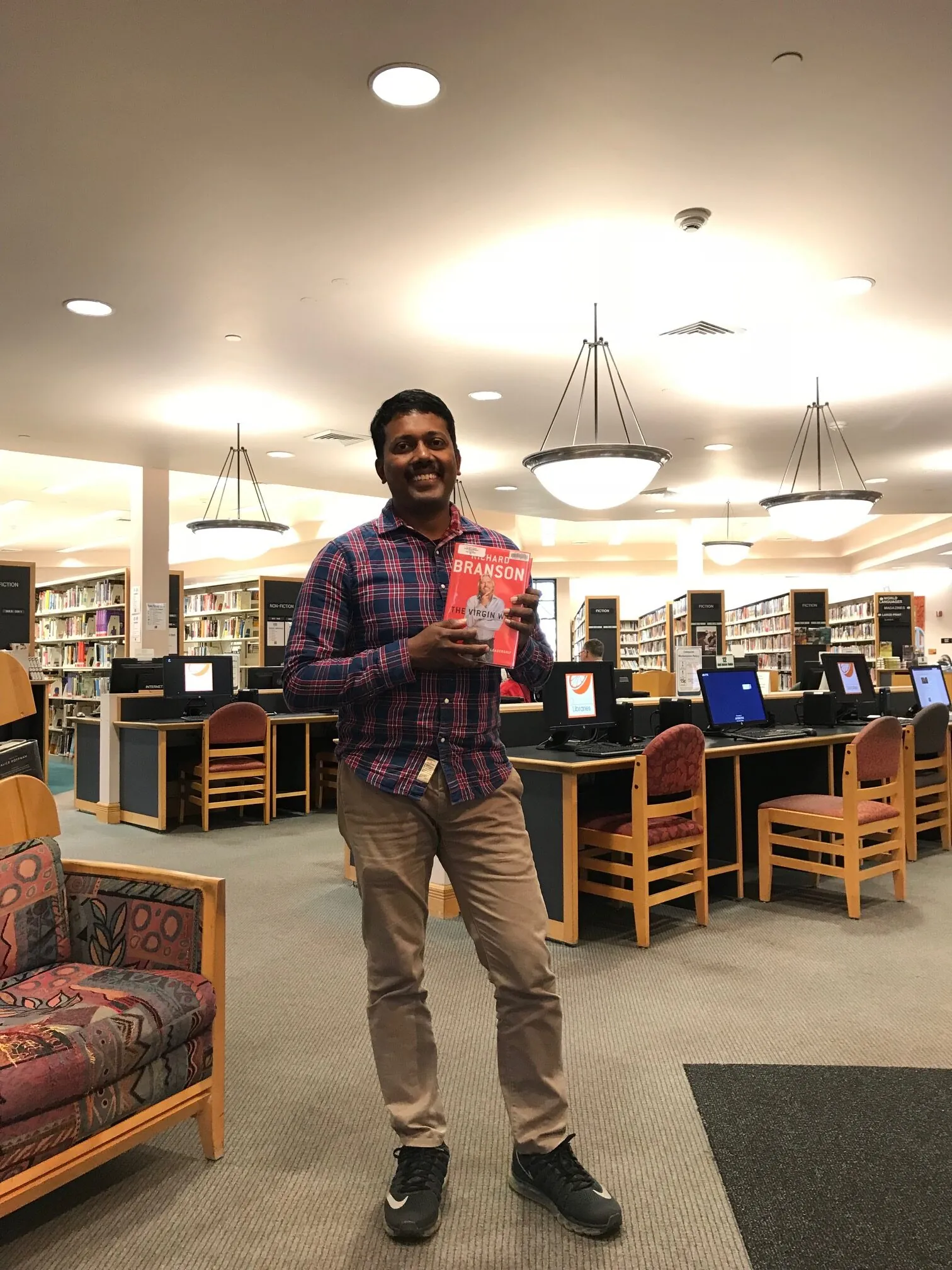
Leave a Reply